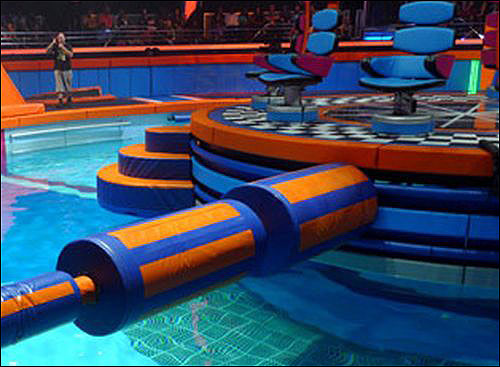On a new television game show known as Oh Sit!, contestants must overcome a variety of obstacles (as well as each other) in an extreme version of the old children’s game, musical chairs. Each chair has a specific cash prize associated with it, so it was vital for the producers to be able to track which contestants sat in which chairs. Which technology did they choose? Bing, bing, bing—radio frequency identification. Correct!
The show features an obstacle course encircling a set of chairs, with music playing in the background. Once the music stops, contestants must scramble for a seat, and the person left standing is then eliminated. In addition, a different cash value is associated with each chair, with the values hidden from players. The contestant sitting in the chair of least value is booted off the show as well.

Since the chair-seating portion earns the contestants cash and secures their win or loss, it is important that the program’s staff know who sat in a particular seat first, even if several people aim for that chair simultaneously. So the producers of the series, which airs on Wednesday evenings on the CW Television Network, needed a method of determining who sat in a chair first, and to capture that data.
The producers chose a radio frequency identification solution codeveloped by Aurora, Colo.-based RFID Inc. and Santa Clarita, Calif.-based Pacific Technical Products (PTP). Passive low-frequency (LF) 125 kHz tags (model 1770) from RFID Inc. were sewn into the participants’ pants. Each tag transmits a unique ID number to RFID Inc.’s 5130 readers, with custom antennas built into each of 10 specially designed chairs, according to James Heurich, RFID Inc.’s president. The TV program’s own software links the tag’s ID to the participant, and the reader to a chair with a specific cash prize, and then calculates the amount of money that each contestant won, based on his or her seating choice.
Oh Sit!’s technical staff first began working with RFID Inc. this past spring, approximately six weeks prior to the show’s taping. The original goal was to track when and how often each contestant completed a lap around the obstacle course, as well as when he or she sat in a chair, and which chair was chosen.
After some initial testing, it became clear that an RFID solution for tracking would be unrealistic, says Bill Monk, CBS‘ electronic supervisor (the CW Network is a joint venture between CBS and Warner Bros. Entertainment). Such a solution would require that passive UHF RFID tags be attached to contestants’ ankles, and the producers found that RF interference from lighting and sound systems and other technology in use, as well as the presence of liquid (the obstacle course includes pools of water), made the reads unreliable.
Instead, RFID Inc. and PTP focused on developing the solution for tracking which players sat in which seat, using LF technology that would interrogate the tags only when a contestant actually sat in a chair, bringing the tag within centimeters of the reader’s antenna. The next challenge was to prevent the reader cables from becoming tangled in—and inhibiting the movements of—the chairs. To address this problem, the two companies employed a custom-designed slip-ring antenna with a flange through which cables are run, that would allow the chairs to swivel without tugging on a cable.
When an individual sits, the tag in the seat of that person’s pants touches the seat of the chair at which the antenna is located, and that tag’s ID is transmitted to an RFID Inc. bridge, located on the pedestal on which the seats are installed. The bridge has a Wi-Fi connection to Oh Sit!’s server, where the software links the ID numbers of the tag and the chair and, in that way, updates the contestant’s cash reward for the game. Because two players may lunge for the same chair simultaneously, Monk explains, RFID would make it possible to know who arrived first, even if both contestants were just inches from the chair.
After the system was designed, CBS received the chairs, which were found to contain metal. Because the reader antennas could not operate as well when placed on metal, CBS installed foam in the chairs during the final days prior to taping, in order to separate the readers and tags from the metal. In addition, Heurich says, “We custom-tuned the reader capacitance and antenna to compensate for the proximity of metal, yet yield the best possible performance.”
Brian Fisher, PTP’s president, says that initially, PTP and RFID Inc. had provided CBS with a demo of the solution using a single reader and three tags. With CBS’ approval, the companies then developed the entire solution. However, Monk says, there were no rehearsals. CBS had only a very short period of time in which to install and test the system in the rented space prior to filming. But the technology worked, Monk states, adding, “It was pretty amazing.” The show is currently halfway through its initial 10-week run, he says, though it may be renewed in October.

